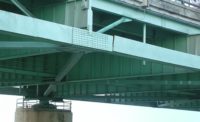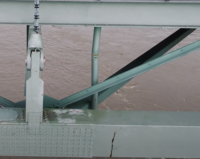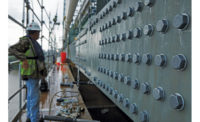Analysis Traces Mississippi River Bridge Beam Crack to Fabrication

This photo from the report conducted by Wiss, Janney, Elstner Associates shows the partial tie-girder fractured identified in May 2021.
(Photo courtesy Tennessee Dept. of Transportation)
The crack in a steel beam that forced an emergency three-month shutdown of the Interstate-40 Hernando De Soto Bridge across the Mississippi River earlier this year likely originated nearly 50 years ago during the component’s fabrication, according to a recently released forensic analysis commissioned by the Arkansas Dept. of Transportation.
Discovered during a routine above-deck inspection of the 3.3-mile-long structure in May, a ½-in thick top flange plate and 1-3/8-in thick vertical plate of the 900-ft-long, 32x26-in tie girder were found to be totally severed, with the fracture extending across nearly half of the bottom flange plate. Additionally, 9 ft of the weld connecting the inside web with the upper flange had separated as well.
The beam section containing the crack was removed from the bridge during the expedited $10-million repair effort led by the Tennessee Dept. of Transportation, which co-owns the structure with ARDOT and oversees its maintenance work. Transported to the Northbrook, Ill., laboratory of Wiss, Janney, Elstner Associates, Inc. (WJE), the section underwent a battery of fractographic and metallographic examinations to determine the cause of the fracture and other contributing factors. The investigative team also tested the material to determine if the steel conformed to relevant ASTM requirements as specified in the original shop drawing requirements.
WJE’s metallographic examination of the fracture surfaces identified two fabrication weld repairs at tie girder thickness transition points that, the report says, “were much wider and contained weld metal deposit sequencing that differed from other side plate thickness transition welds in the bridge.” Those repairs led to the formation of two large hydrogen cracks “as a result of the inherent restraint, improper preheat and/or use of contaminated welding electrodes commonly associated with weld repairs performed without a fracture control plan.”
The report suggests that the hydrogen cracks escaped detection during fabrication and were not detected during a 1982 ultrasonic testing inspection. Years of live loads on the bridge and low ambient air temperatures gradually increased stresses on the tie girders, destabilizing the repair weld cracks. The fracture likely first became evident on the girder’s interior 1 3/8-in-thick vertical side plate, then gradually spread in phases to the top and bottom cover plates. No evidence of fatigue crack growth was found, the report adds.
Because of the bridge’s 48-year service life and efforts to address anomalies at approximately 40 other tie girder thickness transition welds, the WJE report concluded that a similar major fracture is “highly unlikely.” The report does recommend continuing regular biannual arms-length fracture-critical inspections, as well as performing ultrasonic testing at ten-year intervals.
Inspection Program Questions Remain
Though visible in images confirmed to have been taken as early as 2016, the fracture went unreported by multiple annual ARDOT inspections. The inspector who oversaw those assessments, a 15-year agency employee, was fired following an internal investigation shortly after the closure. At ARDOT’s request, the Federal Highway Administration performed a review of the state agency’s policies, procedures and standard operating practices.
FHWA’s report, released November 9, provides 18 recommendations to enhance quality and improve the effectiveness of bridge inspections and follow-up actions. They include updates to quality control and quality assurance procedures, beefed-up training and certification requirements and enhanced inspection procedures.
A day later, ARDOT issued its own after-action report on the emergency repair and inspection. It noted that while employees had expressed concern about the now-terminated inspector’s job performance, management failure to act on those reports “perpetuated a culture where team members did not feel they had the authority or support to question a lead inspector’s procedures or thoroughness.”
In addition, the report said, ARDOT’s Heavy Bridge Maintenance Program “lacked adequate internal controls related to several components of administration and organization.” They included failure to assign a new lead inspector for each annual inspection, and no measures to ensure consistency in carrying out fracture-critical inspections.
ARDOT Director Lorie Tudor said in a statement that the investigations will enable the agency to “move forward with confidence and make the changes necessary to improve our program so that the past will not be repeated.” The agency has already selected new managers for its heavy bridge maintenance section and begun a reorganization of the inspection program.





